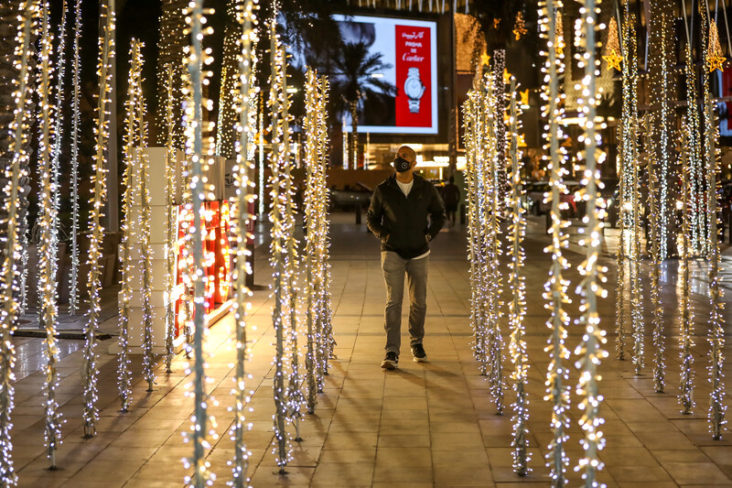Innovative Al Hai Project Put UAE Creative Talent In The Spotlight During Dubai Shopping Festival

Talented UAE-based artists who helped to recreate a traditional Emirati neighbourhood along the streets of Downtown Dubai, using only lights and shadows, have hailed the art project as a high point of their burgeoning careers.
Displayed during the Dubai Shopping Festival (DSF) until 30 January, the Al Hai project was a striking journey down Sheikh Mohammed bin Rashid Boulevard that featured familiar images from a traditional Emirati community, including a Sikka alleyway, a Majlis, a Masjid, a Hewee (or courtyard), a Baqala local store, and a Saha playground game.
Each element was projected through the intricate and innovative use of light lines and shadows to form the boundaries, both visually and metaphorically, of these common features of domestic and architectural life in Dubai’s older neighbourhoods.
A unique part of the Dubai Shopping Festival (DSF) organised by Dubai Festivals and Retail Establishment (DFRE), and held in partnership with Dubai Culture and Emaar, Al Hai was conceptualised and designed by seven UAE-based creatives, among them talented young Emiratis.
Rowdah Alsayegh, Yara Manla, Raghad Al Ali, Fatima Alawadhi and Eman Al Rahma, along with Ahmed Geaissa and Abdullah Khouri, collaborated on the first of its kind lighting project. As specialists in multimedia design, photography, architecture, and product design, the group’s talents and backgrounds were perfectly suited to the Al Hai project.
“The Al Hai light experience was an open cultural museum that provided me with a once in a lifetime experience. I learnt to rise to the challenge with the highest level of group work to create a great project,” said Eman Al Rahma.
Rowdah Alsayegh said the project provided her with inspiration to elevate her own future artistic endeavours. “Al Hai taught me that an artist is a creative who can push beyond one’s title,” she said. “If as a photographer I can achieve light installations, I really can’t wait to see what much more I can do.”
Fatima Alawadhi said: “Al Hai provided me with a unique experience to work with a team with different artistic disciplines. The project came together in challenging times, but we were eager to make it happen. I’m happy to have had my work on display in the most luxurious area, where Dubai welcomes millions of visitors, and I think it’s important to introduce them to our culture in the way Al Hai does. We are grateful for the support shown to art and design schemes in the city.”
Al Hai reflected the need to celebrate, cherish and promote the UAE’s unique history. It was the result of an idea shared by DFRE and Dubai Culture to create a standalone lighting project that would be on display during one of the city’s biggest events.
Conceptualized over four to six months, the seven-strong creative team laid the foundations for the project during meetings at the Al Safa Art & Design Library, which is located in Al Safa one of the city’s oldest neighbourhoods and a source of inspiration for their work. The team held regular workshops and meetings with lighting designers to materialise the final design of Al Hai.
As a fully sustainable art and environmental project, recycled and repurposed lights collected from previous Dubai Shopping Festivals were used to create Al Hai’s features. In particular, the lights used to make the Al Hewee installation came from old lighting used on old palm trees around the city and the birds used in the Al Hewee and Al Sikka were from former DSF structures and installations.
These six elements of Al Hai were interpreted in different ways, including:
- Sikka: An alleyway connecting houses within a traditional Emirati neighbourhood. The light installation translated the sikka experience into a pathway marked by light-reflecting birds placed on the top of light rods.
- Majlis: An essential room in every Emirati house where family, friends and guests gather around a central coffee table. The installation highlighted the main elements of the majlis such as the coffee table, cups and seating cushions.
- Masjid: The mosque where people of the neighbourhood gather to pray. The light installation consisted of arches that represented a mihrab, indicating the direction of the Qibla. The layering arches decreased in scale symbolising a spiritual passage.
- Hewee: The traditional Emirati courtyard, this is considered the heart of the house. This gathering space was set within a defined boundary, overtaken by the Ghaf tree as its main centre of focus. The light installation suspended birds, colourful lights and swings from the tree to represent various activities that would take place around it.
- Baqala: A one-stop-shop where members of the neighbourhood of all ages buy necessities. The light installation utilised layered panels with hanging lights that represented shelves and bottles to create the illusion of a baqala.
- Saha: A playground game that exists between Emirati homes and sikkas. The light installation placed several games as a background to the neighbourhood on the other side of the boulevard making it the perfect backdrop to capture images.
For more information, please visit @dsfsocial on social media channels and www.mydsf.ae.


